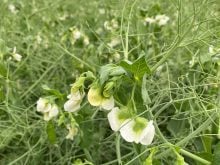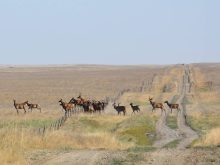EDMONTON — DNA investigations may crack open the secret life of bees.
A federal researcher says exploring the bee genome could locate disease resistance against the varroa mite and different strains of the bacterial infections nosema apis, nosema cereanae and American foul-brood disease (AFB).
“Among the honey bee diseases, (AFB) is one of the most serious ones because it can lead to complete colony death,” said bee researcher Steve Pernal, who works at the Agriculture
Canada Research Centre near Beaverlodge, Alta.
Read Also

Crop quality looks good this year across Prairies
Crop quality looks real good this year, with the exception of durum.
He is working with post doctoral fellow Shelley Hoover on a western Canadian project to survey disease levels and find immunity.
“The honeybee was one of the early organisms to have its genome mapped, so that was quite a momentous announcement in science,” Pernel said following a presentation of his preliminary research findings at the Alberta Beekeepers Commission’s recent annual meeting in Edmonton.
The genomic research analyzed thousands of proteins found in DNA and isolated 15 that seem to be significant in contributing to disease and mite resistance.
“We are looking at the expression of proteins to try and give us a unique way of trying to identify disease and varroa mite resistance in bees,” Pernal said.
“The Holy Grail is a quick test for the beekeeper to use.”
Finding colonies that work harder to keep hives clean is one direction of the study.
Hoover said hygienic behaviour among bees is highly heritable and passed onto succeeding generations.
They have also found that hives with high hygienic behaviour appear to have less infection. The bees quickly remove diseased and dead bodies and seal off the area within 24 hours.
“We have a long way to go in regards to this trait,” said Hoover.
Breeders want high honey production when selecting queens, but finding bees that pass on the tidiness trait is also important.
The researchers hope to distribute descendents of these queens to commercial producers in 2013 for further testing. Another large scale disease survey will be conducted in Western Canada at that time.
Hoover has worked with 12 beekeepers in the four western provinces, studying 455 colonies and collecting 1,400 samples for various aspects of the study.
One part of the study is researching the varroa mite, which has been linked to widespread bee deaths in recent years.
The surveys found the eight-legged, oval shaped mite is present in hives across the West.
An annual census of the Alberta industry found 769 beekeepers, with the most being in northwestern Alberta and the Peace River district. The province has 40 percent of Canada’s colonies, making it the third largest beekeeping province behind Ontario and Quebec.
Alberta produced 34 million pounds of honey in 2010 with farmgate receipts of $57 million and exports worth nearly $16 million.
China, Argentina, Turkey, Ukraine and the United States are the top five world producers of honey. Canada ranks 24th.















